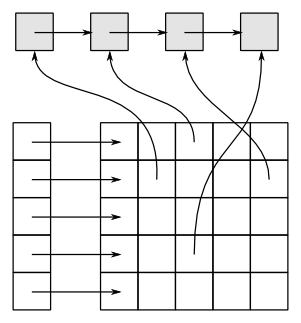This project is a research for the viability of an high-parallel implementation of the Conway's 'game of life'. I've parallelized at thread level with OpenMP and at process level with OpenMP.
I designed a complex structure in order to try to reduce the number of memory accesses and improve the iteration time.
I've chosen a two dimensional array of pointers to node of linked list. In the linked list I save the cells that must be checked. The array allow to access to the neighbors with an constant order. On the other hand, the linked list allow to check only the cells susceptible to change its state.
With this structure we obtain a processing time independent of world size, but it dependent linearly on number of alive cells. If we have a number of alive cells close to the world size, we should obtain a process time slightly higher to an array based implementation approach.
For thread parallelization each thread processes an equal portion of the linked list.
For the process parallelization, i divide the world into equal portions along x axis. Each process processes its portion, sends changes at limits to the top and bottom process, and receives the changes at limits too.
The top 'makefile' automatically creates 'build' directory, calls 'cmake' and builds the project.
For run:
$> mpirun -n <number of process> build/gameOfLife <options (see help)>
For small worlds you can activate the 'record' flag (-r or --record) for generate a record of whole execution. Later, you can view this record with the 'viewer.sh' script. The control keys are:
- 'p' : pause/continue
- '+' : increment velocity
- '-' : decrement velocity
- 'b' : backward
- < other key > : forward
- openmpi v1.6.5
- openmp
- gnuplot [for generate graphics]
These tests were executed on a machine with an Intel Pentium Dual Core at 2 GHz with 4GB of RAM.
You can view all results here.
